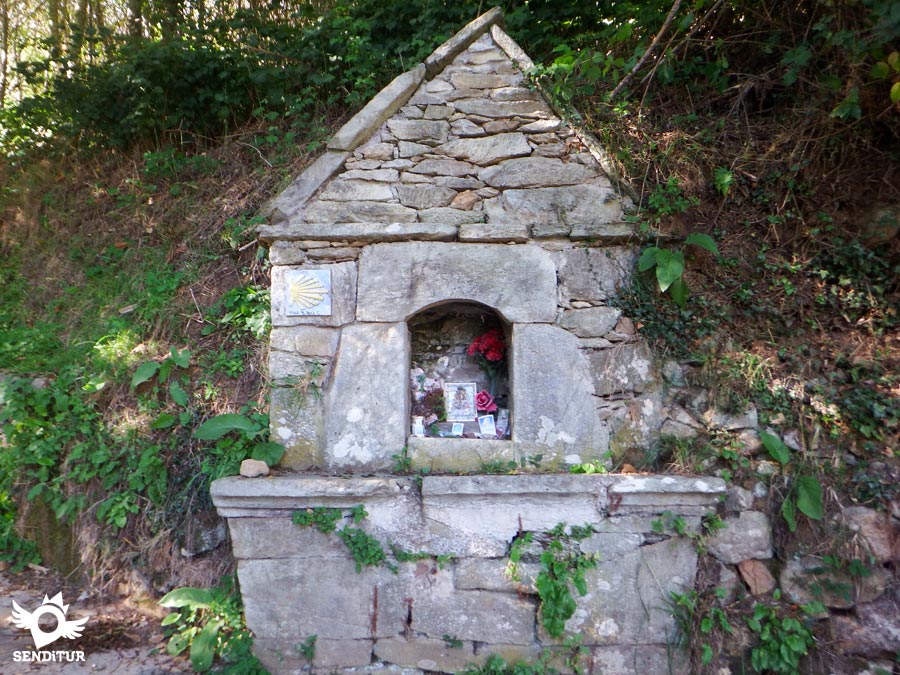It's a place and Montefurado a casería of the parish of Lago in the council of Allande by where the Primitive Way passes. Lago is located on the right side of the peak of the same name, next to the river Ouro. And Montefurado is located on the crest of the mountain range that extends to the west in the foothills of the Sierra del Palo, under the heights of the Xesto da Fonte. The Sierras de Valledor and Los Lagos, in which Lago and Montefurado are located, conserve countless remains of their primitive population settlements and their cultures. Numerous funerary tumuli mark out these mountain ranges, and up to eleven castros from the Roman period have been counted, which is very normal if one takes into account the intense gold mining activity that supported the area. Montefurado owes its name to the galleries that the Romans made and that cross the mountain on which it sits, furaos mountains, "agujereados". Montefurado had a hospital for pilgrims, the first building is not known when it was founded but it was in the year 1744 when it was rebuilt.

Lago has a beautiful popular architecture of slate roofs, in which traditional constructions are mixed with others of different styles. Its parish church of Santa María was built in the 18th century on top of a previous one, in the belfry, from the 18th century, there is a bell from the 16th century. Next to the temple there is a yew tree, sacred to the Celts, which has been considered a Natural Monument since 1995 and which, with its large dimensions, 9 metres in crown diameter, 16 metres in height and 5.5 metres in trunk diameter, has been part of the history of the village for more than 500 years. Today it is a landmark on the Primitive Way to Santiago, as well as being a point of interest on a hiking route known as the Route of the Teixos, which links the yew trees of Lago with the one of Santa Coloma. In Montefurado, the chapel of Santiago belonged to the old pilgrims' hospital that existed here, where today is the Casa del Hospital or Casa'l Pintu as it is known. The image of Santiago, which keeps the chapel, was once painted yellow, a rare fact that made it famous among pilgrims who walked the Primitive Way. Very close to the village is the legendary Cova de Xuan Rata, which is a tunnel perforated in the rock, a vestige of the old gold mines.

Lago and Montefurado, like the rest of the council of Allande, celebrate the 8th of September in honour of Nuestra Señora del Avellano.
The Yew trees were sacred trees in the Celtic culture and around them they gathered on great occasions. The Church, in its work of Christianizing these people and their culture, ordered chapels and churches to be built next to these trees. The traditional saying that we all know of "throwing the yews" seems to come from the fact that when the girls left the religious services, they took seeds and twigs from the nearby yew tree and threw them to the boy they liked.
The galleries and tunnels drilled by these saws were made to transfer water from the river del Oro to the river Castelo in order to supply the laundries with precious metal. Furthermore, in these Roman gold mines, large bonfires were built inside the galleries and when high temperatures were reached, a good flow of water entered suddenly and with its coldness an explosive effect was obtained, causing the breaking and detachment of the mountain, exposing the vein of the noble metal.

Legend has it that in the cave near Montefurado known as Xuan Rata, many, many years ago there was a huge snake that ate the crops and even the cattle, frightening the people of the village who did the impossible not to have to face it. One day a brave young man from the area, Xuan Rata llamabase, thought that it was time to give her a good lesson and knowing the voracity of the reptile took a flat and dark stone, heated it to the red heat offering it to the bug who swallowed it as if it were a delicacy, but immediately noticed the fire that broke out inside his stomach and sneaking into the cave disappeared and was not seen again. Since then the cave has been called Xuan Rata.
Lago and Montefurado can be reached by following the AS-14 road that connects them with Pola de Allande and Grandas de Salime.
In Lago and Montefurado there is a bus stop on the Tineo-Grandas de Salime line. The telephone number for more information is 985 969 600.
Lago
Montefurado
SENDITUR is not responsible for any variation in the information described, as well as for the misuse of its guides and recommends that everyone be responsible and prudent in carrying out the activity. Likewise, we invite you to document yourself with books and specialized guides to complement the information described. From the commitment of SENDITUR with Nature and the respect to the balance of the environment, SENDITUR urges you to travel in a responsible way, with low environmental impact and respecting at all times the Natural, Cultural and Social environment wherever you go. For any suggestion, SENDITUR invites you to send an email to
Continue watching …